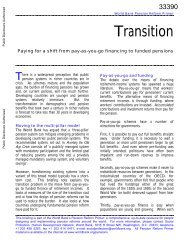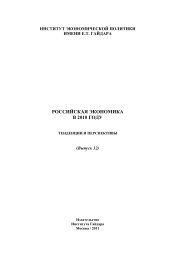Financial Sector Development in Africa: Opportunities ... - World Bank
Financial Sector Development in Africa: Opportunities ... - World Bank
Financial Sector Development in Africa: Opportunities ... - World Bank
Create successful ePaper yourself
Turn your PDF publications into a flip-book with our unique Google optimized e-Paper software.
128 Walley<br />
classed <strong>in</strong>to general microf<strong>in</strong>ance lenders offer<strong>in</strong>g a hous<strong>in</strong>g product and<br />
those more focused on loans for hous<strong>in</strong>g purposes. The term hous<strong>in</strong>g<br />
microf<strong>in</strong>ance may be relatively new, but the concept has been around for<br />
a long time. These <strong>in</strong>stitutions make small loans that are typically used for<br />
<strong>in</strong>cremental build<strong>in</strong>g or home improvement. The loan may come after a<br />
sav<strong>in</strong>gs period or be the result of earlier successful loan repayments. This<br />
is the way a borrower is qualified for a larger, longer-term loan <strong>in</strong> the<br />
absence of any formal credit history. One of the more successful providers<br />
<strong>in</strong> <strong>Africa</strong> has been the Kuyassa Fund <strong>in</strong> South <strong>Africa</strong>, which may<br />
provide a possible model for other markets. Given the relative wealth of<br />
borrowers and the level of <strong>in</strong>formality <strong>in</strong> terms of both <strong>in</strong>come and property<br />
ownership, hous<strong>in</strong>g microf<strong>in</strong>ance has enormous potential, but it<br />
needs to ga<strong>in</strong> scale for it to become viable as a commercial activity.<br />
Some <strong>Africa</strong>n countries have gone down the route of specialized s<strong>in</strong>gle<br />
purpose nonbank mortgage lenders, or monol<strong>in</strong>e lenders. Most notable<br />
among these countries are Nigeria, which has primary mortgage <strong>in</strong>stitutions;<br />
the Arab Republic of Egypt, which has mortgage f<strong>in</strong>ance companies;<br />
Kenya, which has hous<strong>in</strong>g f<strong>in</strong>ance companies; and South <strong>Africa</strong>, which<br />
has f<strong>in</strong>ancial services providers specializ<strong>in</strong>g <strong>in</strong> mortgage lend<strong>in</strong>g. Typically<br />
these <strong>in</strong>stitutions have a narrow bank<strong>in</strong>g license that limits their activities;<br />
<strong>in</strong> particular, they are restricted on deposit collection. This means<br />
that they typically rely on wholesale fund<strong>in</strong>g on the liabilities side of their<br />
balance sheet. This type of <strong>in</strong>stitution has proved to be particularly vulnerable<br />
dur<strong>in</strong>g the crisis, when its cost of funds has risen to a much<br />
greater extent than those lenders who have a deposit base. One response<br />
has consolidation <strong>in</strong> the f<strong>in</strong>ancial sector, with banks acquir<strong>in</strong>g specialist<br />
mortgage bus<strong>in</strong>esses or start<strong>in</strong>g up their own. This is the case <strong>in</strong> Kenya<br />
(S&L acquired by KCB); <strong>in</strong> Egypt, where a number of mortgage f<strong>in</strong>ance<br />
companies have been acquired by banks; and <strong>in</strong> Nigeria, where banks<br />
have been sett<strong>in</strong>g up primary mortgage <strong>in</strong>stitution subsidiaries to carry<br />
out their mortgage lend<strong>in</strong>g bus<strong>in</strong>ess. This bank/subsidiary model allows a<br />
specialization <strong>in</strong> mortgage lend<strong>in</strong>g, and it may attract some regulatory<br />
benefits, but it avoids the fund<strong>in</strong>g downside because the bank can fall<br />
back on a large deposit base.<br />
The f<strong>in</strong>al category of lenders <strong>in</strong> <strong>Africa</strong> comprise those that operate <strong>in</strong><br />
the semi-formal area. They are often collectively referred to as sav<strong>in</strong>gs<br />
and credit cooperatives (SACCOs), but can <strong>in</strong>clude community banks<br />
or credit unions. They operate <strong>in</strong> the space between the formal bank<strong>in</strong>g<br />
sector and the much more <strong>in</strong>formal microf<strong>in</strong>ance lenders or the “susu”<br />
sav<strong>in</strong>gs schemes. How well established these semi-formal lenders are and







